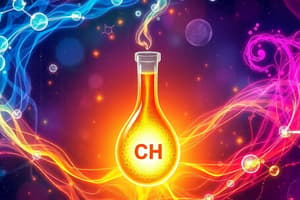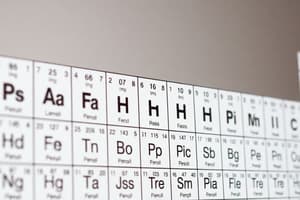Podcast
Questions and Answers
What defines an endothermic reaction?
What defines an endothermic reaction?
An endothermic reaction absorbs heat, resulting in products with higher energy than the reactants.
How do catalysts affect reaction rates?
How do catalysts affect reaction rates?
Catalysts increase reaction rates by lowering the activation energy required for the reaction.
What is the difference between a solute and a solvent?
What is the difference between a solute and a solvent?
The solute is the substance that is dissolved, while the solvent is the substance in which the solute is dissolved.
What are functional groups in organic chemistry?
What are functional groups in organic chemistry?
Why is Personal Protective Equipment (PPE) important in chemistry?
Why is Personal Protective Equipment (PPE) important in chemistry?
What are the basic components of an atom?
What are the basic components of an atom?
How do ionic bonds form?
How do ionic bonds form?
What distinguishes a compound from a mixture?
What distinguishes a compound from a mixture?
What is the characteristic of elements in the same group on the periodic table?
What is the characteristic of elements in the same group on the periodic table?
What is an example of a chemical reaction that produces energy?
What is an example of a chemical reaction that produces energy?
Define acids according to their behavior in solution.
Define acids according to their behavior in solution.
What is the significance of balancing chemical equations?
What is the significance of balancing chemical equations?
How does the state of a solid differ from that of a gas?
How does the state of a solid differ from that of a gas?
Flashcards are hidden until you start studying
Study Notes
Basic Concepts of Chemistry
- Atoms: Basic unit of matter; consist of protons, neutrons, and electrons.
- Molecules: Combinations of two or more atoms bonded together.
- Elements: Pure substances that cannot be broken down; defined by the number of protons (atomic number).
- Compounds: Substances formed when two or more elements are chemically bonded.
The Periodic Table
- Arrangement: Elements organized by increasing atomic number and grouped by similar chemical properties.
- Groups/Families: Vertical columns; elements have similar chemical behavior (e.g., Alkali metals, Halogens).
- Periods: Horizontal rows; properties change progressively across a period.
Chemical Bonds
- Ionic Bonds: Formed between metals and nonmetals through the transfer of electrons; results in charged ions.
- Covalent Bonds: Formed when two nonmetals share electrons.
- Metallic Bonds: Bonds between metal atoms; electrons are shared in a sea of delocalized electrons.
Chemical Reactions
-
Types:
- Synthesis: Two or more reactants combine to form one product.
- Decomposition: One compound breaks down into two or more products.
- Single Replacement: One element replaces another in a compound.
- Double Replacement: Exchange of ions between two compounds.
- Combustion: Reaction with oxygen producing energy, carbon dioxide, and water.
-
Balancing Reactions: Law of conservation of mass requires that the number of atoms of each element must be the same on both sides of the equation.
States of Matter
- Solid: Fixed shape and volume; particles closely packed.
- Liquid: Fixed volume but takes the shape of the container; particles are less tightly packed.
- Gas: No fixed shape or volume; particles are far apart and move freely.
Acids and Bases
- Acids: Substances that donate protons (H⁺) in solution; sour taste; pH < 7.
- Bases: Substances that accept protons or release hydroxide ions (OH⁻); bitter taste; slippery feel; pH > 7.
- Neutralization: Reaction between an acid and a base to produce salt and water.
Stoichiometry
- Mole Concept: A mole represents 6.022 x 10²³ particles of a substance.
- Molar Mass: Mass of one mole of a substance, expressed in grams per mole.
- Conversions: Use molar ratios from balanced equations to relate quantities of reactants and products.
Thermodynamics in Chemistry
- Endothermic Reactions: Absorb heat; products have higher energy than reactants.
- Exothermic Reactions: Release heat; products have lower energy than reactants.
- Activation Energy: Minimum energy required to initiate a reaction.
Kinetics
- Reaction Rate: Speed at which reactants are converted to products; affected by concentration, temperature, and catalysts.
- Catalysts: Substances that increase reaction rates without being consumed.
Solutions
- Solvent: The substance in which the solute is dissolved (e.g., water).
- Solute: The substance that is dissolved (e.g., salt).
- Concentration: Measure of how much solute is present in a given volume of solvent.
Organic Chemistry
- Hydrocarbons: Compounds consisting of carbon and hydrogen; can be aliphatic (straight-chain or branched) or aromatic (cyclic).
- Functional Groups: Specific groups of atoms within molecules that determine chemical reactivity (e.g., hydroxyl, carboxyl).
Safety in Chemistry
- Personal Protective Equipment (PPE): Gloves, goggles, lab coats to protect against chemical exposure.
- Proper Handling: Follow protocols for storing, mixing, and disposing of chemicals to prevent accidents.
Basic Concepts of Chemistry
- Atoms are the fundamental units of matter made up of protons, neutrons, and electrons.
- Molecules comprise two or more atoms bonded together.
- Elements are pure substances identified by their atomic number, which is the number of protons in the nucleus.
- Compounds are substances formed from the chemical bonding of two or more different elements.
The Periodic Table
- Organized by atomic number, with elements grouped by similar chemical properties.
- Groups or families, depicted as vertical columns, include elements with comparable behaviors (e.g., Alkali metals, Halogens).
- Periods are horizontal rows representing a gradual change in properties across the table.
Chemical Bonds
- Ionic bonds occur between metals and nonmetals, involving the transfer of electrons and resulting in charged ions.
- Covalent bonds are formed through the sharing of electrons between two nonmetals.
- Metallic bonds connect metal atoms with a shared pool of delocalized electrons.
Chemical Reactions
- Synthesis reactions combine two or more reactants to form a single product.
- Decomposition reactions involve a compound breaking down into two or more products.
- Single replacement reactions have one element substituting for another in a compound.
- Double replacement reactions exchange ions between two diverse compounds.
- Combustion reactions occur with oxygen, yielding energy, carbon dioxide, and water.
- Balancing reactions is based on the law of conservation of mass, ensuring equal atom counts on both sides.
States of Matter
- Solids maintain a fixed shape and volume, with tightly packed particles.
- Liquids have a fixed volume but adapt to the shape of their containers, featuring less tightly packed particles.
- Gases lack a fixed shape or volume, consisting of particles that are dispersed and move freely.
Acids and Bases
- Acids are proton (H⁺) donors in solution, generally sour, with a pH less than 7.
- Bases are proton acceptors or yield hydroxide ions (OH⁻), often bitter and slippery, with a pH greater than 7.
- Neutralization occurs when an acid reacts with a base to create salt and water.
Stoichiometry
- The mole is a measurement representing 6.022 x 10²³ particles of a substance.
- Molar mass quantifies the mass of one mole of a substance, expressed in grams per mole.
- Conversions use molar ratios from balanced equations to correlate reactant and product quantities.
Thermodynamics in Chemistry
- Endothermic reactions absorb heat, leading to products with higher energy than the reactants.
- Exothermic reactions release heat, resulting in products with lower energy than the reactants.
- Activation energy is the minimum energy necessary to initiate a chemical reaction.
Kinetics
- The reaction rate indicates how quickly reactants turn into products, influenced by concentration, temperature, and the presence of catalysts.
- Catalysts are substances that accelerate reaction rates without being consumed in the process.
Solutions
- Solvents dissolve the solute (e.g., water) in a solution.
- Solutes are the substances being dissolved (e.g., salt).
- Concentration measures the quantity of solute in a given volume of solvent.
Organic Chemistry
- Hydrocarbons are compounds formed from carbon and hydrogen, classified as either aliphatic (straight-chain or branched) or aromatic (cyclic).
- Functional groups define specific atom arrangements in molecules that determine their chemical reactivity (e.g., hydroxyl, carboxyl).
Safety in Chemistry
- Personal protective equipment (PPE) like gloves, goggles, and lab coats is essential for preventing chemical exposure.
- Proper handling procedures must be followed for storing, mixing, and disposing of chemicals to ensure safety and minimize accidents.
Studying That Suits You
Use AI to generate personalized quizzes and flashcards to suit your learning preferences.




